What is The Foreign Account Tax Compliance Act …

Data Science & AI expertise combined with consulting services enable customers to embrace all aspects of Generative AI
In the coming years, Generative AI will produce significant business impacts. Generative technology and related AI software has the potential to revolutionize key industry functions such as marketing, sales, risk analysis, fraud detection, customer service, and investment strategies.
Generative AI could bring disruption at scale to businesses. To face the challenges ahead, leading companies must adopt a pragmatic approach to leveraging the potential of generative AI and must implement the golden rules for a successful integration into their operating model.
To achieve a successful, pragmatic approach in the delivery of generative AI applications, businesses must implement organizational prerequisites related to the operating model, including data management. In addition, dedicated structures that can operate with high levels of autonomy need to be put in place to disrupt existing business processes, to leverage the broad range of tasks generative AI can address, and to establish partnerships.
On top of rapid advancement and adoption of these AI evolutions, technology, business, government, and academic leaders must take responsibility and address safety, ethics, and transparency concerns. Real issues of data privacy, intellectual property, regulatory compliance, and “deep fakes” should be top of mind for executive leaders.
Leading companies must now adopt a pragmatic approach to leveraging Generative AI potential. Successful implementation will be based on three pillars:
Our conviction is that the “Adoption” and “Experimentation” phases must be started as soon as possible to achieve a successful pragmatic approach in harnessing the value of Generative AI.
Sia Partners offerings cover all 3 phases, Acculturation, Experimentation, Adoption:
We support our customers' Acculturation initiatives by delivering Acculturation Programs dedicated to C-Level, and Hands-on sessions for Management teams.
We boost the Experimentation phase thanks to our ideation accelerators based on Design Thinking techniques. Combined with our expert Data Science team, we help prioritize use cases and build proof of concepts in a short timeframe, leveraging the R&D efforts of our data scientists to master and prototype all AI technologies. A proof of concept of a use case is generally deployed in 3-6 weeks.
Our engineering culture and proven track record of PoC to industrial AI tool deployment, combined with our transformation and change consulting competencies, are levers to transition efficiently from Experimentation to Adoption.
With a team of over 300 AI specialists, data scientists, and data engineers, operating from eight centers of excellence over the world, Sia Partners accompanies clients in their AI journey by delivering unparalleled value.
The launch of ChatGPT on November 30th, 2022 led Artificial Intelligence into a new era. Although AI history is currently witnessing a paradigm shift - ChatGPT counted 1 million users after 5 days, whereas it took Facebook 10 monthsand Twitter 2 years to reach that threshold - the underlying techniques have not been invented in the last few months. Some experts are now calling this step an "evolution" rather than a "revolution".
Yet, ChatGPT has been disruptive since it unveiled the capabilities of Generative AI technologies by opening them to everyone, from a simple and user-friendly chatbot interface, with the ability to cover a large scope of use cases.
AI is a broad term that refers to any machine that can learn and perform tasks that would typically require human intelligence.
Unlike traditional discriminative AI techniques, which improve decision-making by analyzing data, Generative AI can create new content, such as text, images, audio, and video, therefore augmenting human capabilities.
It does this by learning patterns from existing data, then using this knowledge to generate new and unique outputs.
Generative AI produces highly realistic and complex content that mimics human-like creativity, making it a valuable tool for many industries.
Generative AI is generally prompted by text or speech, using natural language, before it can create new outputs and prompt windows to appear in a lot of applications (search engine, office tools, creativity tools…).
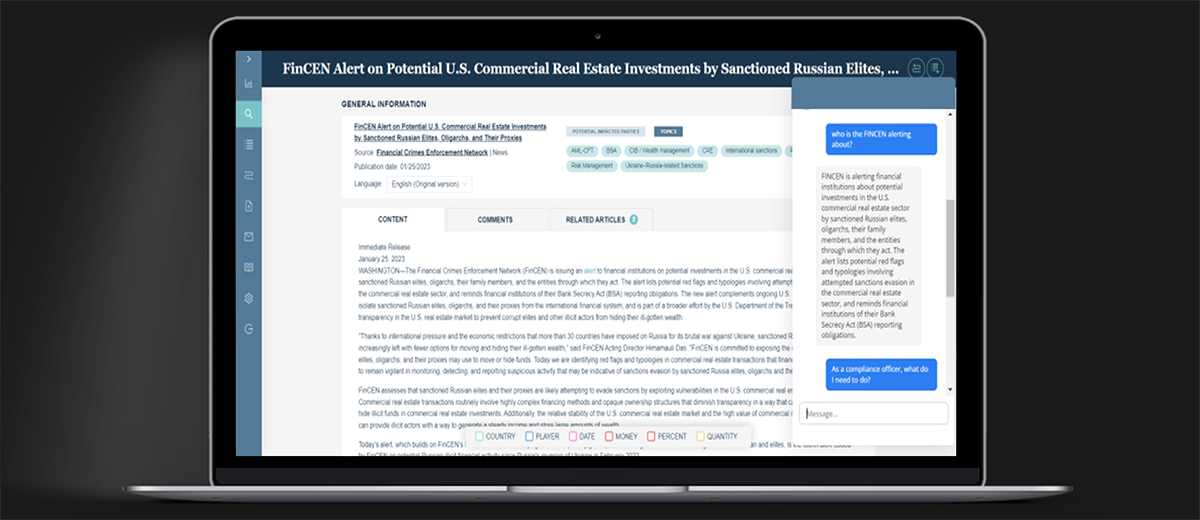
Integration of the SiaGPT prompt into Sia Partners' RegReview compliance solution
Click through the below images to discover a brief history of AI leading to Generative AI.
Generative AI can automate many tasks that are currently done by humans, freeing up time for people to focus on more creative and strategic work.
Generative AI can produce high-quality content that is more consistent and accurate than human-generated content.
Generative AI creates new possibilities for innovation. For example, it can be used to create new products and services, improve existing ones, and automate tasks.
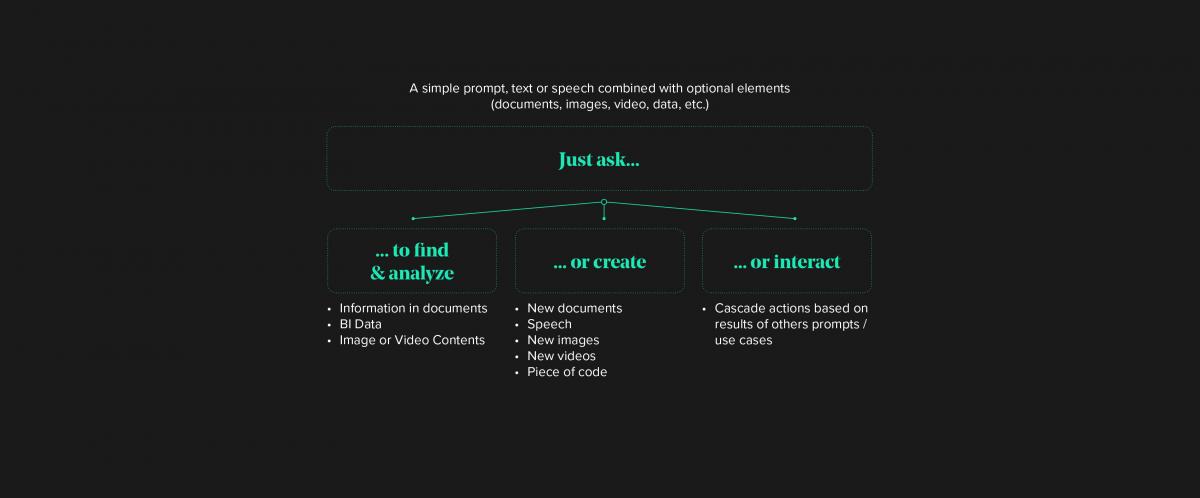
Main areas of application
Create new texts for blog posts, news articles, IP and even creative fiction. This could save a lot of time in compiling memos and presentations.
Create new images with only a few words of text input. This could be highly efficient in adding illustrations, icons and other visual aids to documents, digital sites and presentations.
Using text-to-video, this process allows the generation of videos with realistic AI avatars and voice-overs in minutes, including realistic characters, objects and backgrounds.
Using a process of deep learning, generative AI will create new audio content such as music, speech (e.g. voice-overs) or any other type of audio content (e.g. audio effects).
Creating 3D assets is extremely time-consuming. Generative AI can speed up the process by creating realistic 3D models, shapes and textures, based on learned data patterns.
Users have shown preference in using ChatGPT and Bard as a coding starting point to generate a block of code based on a prompt, to assist with code solutioning, and to improve or update a current code block.
Generative AI technologies are based on “foundation” models, designed to capture the statistical patterns and semantic relationships present in a massive amount of data (the GPT-3 LLM used to build ChatGPT foundation model was trained on more than 500 billion words).
Once a foundation model is trained, it can be fine-tuned for specific applications or tasks.
When using Generative AI tools like ChatGPT, Bing, Bard, Midjouney, users asks questions through a prompt. The foundation model is used to analyze and understand the input. The model retrieves relevant information from its knowledge base, and generates a response based on the understanding of the context and the relevant information retrieved.
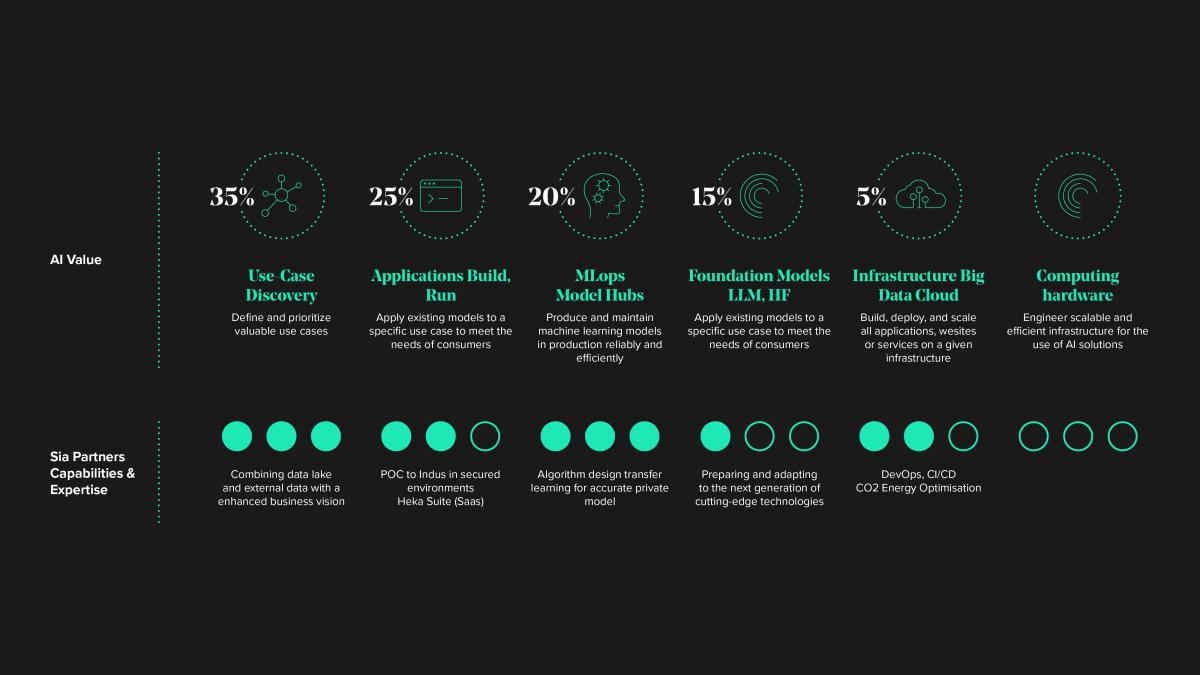
Generative AI value chain
The current market landscape of generative AI is rapidly growing, with new players, applications and tools emerging all the time.
The market is expected to reach $100 billion by 2025.
Here are some of the key drivers we see supporting the growth of the market:
Increasing availability of data and computing power, including the emergence of quantum computing;
Growing demand for individualized customer experience journeys;
A further need to automate tasks and processes;
The increasing focus on rapid growth, innovation and creative prowess.
Use cases for Generative AI techniques can be split into 3 main categories:
Intrinsic use cases that will be available to every company and every employee as they will be natively embedded in collaboration tools, office tools, search engines, design tools, etc.
Market Standard use cases that will be the top priority for all companies like chatbot enhancement for customer care, intelligent information retrieval from company databases, document generation, BI automation etc. Companies will have to build their specific tools for these usages, but they will not create competitive advantage, since every company must develop them if they don’t want to be left behind.
Competitive Advantage use cases will unlock entirely new opportunities for businesses. These can lead to the creation of new revenue streams and market differentiation.
Alongside this classification, the questions around resources and skills needed to develop these use cases will arise. In the future, we will be able to split this effort into:
Ready to use technologies are embedded in software that's already available on the market, users need to be trained to use them correctly and efficiently.
Development: a company’s software needs to be connected to pre-built, off-the-shelf tools developed by Generative AI providers, or no-code AI tools for simple customization. The effort is in connecting a company’s IT tools with a Generative AI component, much like connecting different systems through APIs. “Development” doesn’t require specific data science capabilities.
Tuning models car be necessary to achieve better performance in certain use cases. The performance gain could be in model accuracy, but also cost or IT resource usage. For dedicated use cases, a small model (with fewer parameters like billions in place of hundreds our thousands of billions) will provide the same accuracy as larger ones, but will be more efficient in terms of resources consumption and ability to maintain the model. Data Science competencies are required for tuning.
Building a specific foundation model can be necessary to tackle use cases that are far from classical pre-trained models. Expert competencies are required, vast amounts of data are necessary, and computer resources are immense. Only a few companies will develop this kind of effort, to build use cases that will lead to a real competitive advantage
Generative AI provides potential uses cases in all sectors, for companies of all size.
Sia Partners classification of these use case relies on 3 axes:
Sector-impacted: focussing on one specific sector or sector-agnostic.
Type of impact: employee augmentation, system/process enhancement, new offerings.
Anticipated ROI: savings, competitive, disruptive.
A combination of this classification, and the effort required to develop use cases, enables businesses to prioritize use cases and build a Generative AI roadmap.
The golden rules for a successful implementation include Acculturation, Experimentation, and Adoption:
Acculturation is educating the organization about these technologies. It should be accompanied by a long-term change management phase. These technologies will replace certain jobs but will significantly enhance others, such as creative and engineering professions, which previous technologies could not boost in the same way.
Experimentation is mandatory in evaluating the potential of these technologies within a company’s ecosystem and prioritizing the initial use cases. While some companies have halted all activities due to data security fears, tools are evolving fast, notably driven by their integration into cloud hyperscaler platforms, to ensure safe experimentation.
Adoption involves implementing basic and high-value use cases on a larger scale, accompanied by change management and transformation. It requires setting up an agile operating model for an efficient delivery, capable of adapting to the rapid evolution of AI technologies. Business disruption, bringing about competitive advantage, will include leveraging the broad range of tasks generative AI can address, where preceding AI technologies were focused on specific use cases. If these new technologies create numerous opportunities for value creation, their sustainable adoption will necessitate evaluating and mitigating the associated risks.
The progressive, far-reaching, and inevitable, spread of Generative AI technologies will have a profound impact on the way companies are organized.
Whatever the degree of adoption within the company, these technologies will appear intrinsically, since they will be natively embedded in collaboration tools, office automation tools, search engines, specialized software, etc., resulting in the automation of tasks that are today carried out by employees, as well as an “augmentation” of other activities.
Companies that deploy these technologies more extensively will be impacted in a more disruptive way, to create more value and competitive advantages.
As long as they define, prioritize and assess the use cases they want to deploy, companies will update their strategic workforce planning to take into account new jobs directly linked to AI (ML engineers, prompts engineers,etc.), but will also take into account the impacts on the rest of the teams to anticipate the disappearance of certain jobs, the need for training or recruitment of others.
To date, there has been little feedback on how companies have organized themselves in the face of the widespread deployment of Generative AI and disruptive technologies. However, we can assume that:
agile methodologies will remain the most appropriate in terms of software development, given the speed of evolution of Generative AI technologies, which render the performance of previous generations obsolete in a matter of weeks;
as Generative AI models are much broader than traditional AI models, the "one use case / one model" approach that prevailed with discriminative AI could create a risk of "siloing", limiting the scope and disruption of Generative AI. What kind of organization should be put into place to avoid this pitfall? Do we need to involve more businesses/departments when designing a use case, or do we need to go as far as centralizing foundation models' build and run in a single dedicated team, serving the company's various businesses and tools?
Key enablers for Generative AI Adoption

Several factors will accelerate Adoption
To avoid repeating the errors of the past, there is a growing awareness surrounding the risks attached to generative AI. Here are some of the most common risks:
Data leaks: proprietary data can leak from the company if they are used to train generative AI models.
Misinformation: as generative AI draws its data from existing sources, we need to curb the propagation of fake news and other forms of misinformation.
Bias: generative AI can perpetuate the biases of the data they are trained on.
Deepfakes: the combination of universal translation and generative AI in video and audio, poses a serious threat to misuse in generating deepfakes.
Job displacement: the automation of many jobs could lead to displacement in several industries.
AI Hallucinations: unreliability of information.
Usage of generative AI for next generation cyberattacks.
“Shadow” AI: generative AI could be banned of certain companies / departments, but employees may use external tools, available in one-click, creating a risk of data leaks but also a risk to the decision-making process.
Liability: if 3rd parties utilize generative AI services, who is ultimately liable when those services are being misused to infringe upon consumer privacy?
IP ownership: who ultimately owns the IP linked to creative output where generative AI was a part of?
Licensing: should there be a licensing system similar as that to banking to indicate those who can deliver generative AI services and need to abide to rigorous standards and norms? In addition, should this be organized on a global scale?
Algorithm discrimination: how to prevent biases to creep into the AI learnings?
Several large companies are banning or restricting employees from using generative AI tools like ChatGPT.
Beyond aligning to applicable laws & regulations, consider the following:
Issuing guidance that requires employees to review any output generated by generative AI for accuracy, appropriateness and usefulness before accepting it.
Prohibiting the use of generative AI for sensitive or confidential data or using a private version of the tool that does not share data with external parties.
Working with subject matter experts, auditors and technologists to ensure the reliability and quality of the data and output generated by generative AI.
Generative AI activities has a patchworked regulatory framework : although no specific legal text rules it’s use, existing general principles of multiple regulations remain applicable to the use of generative AI.
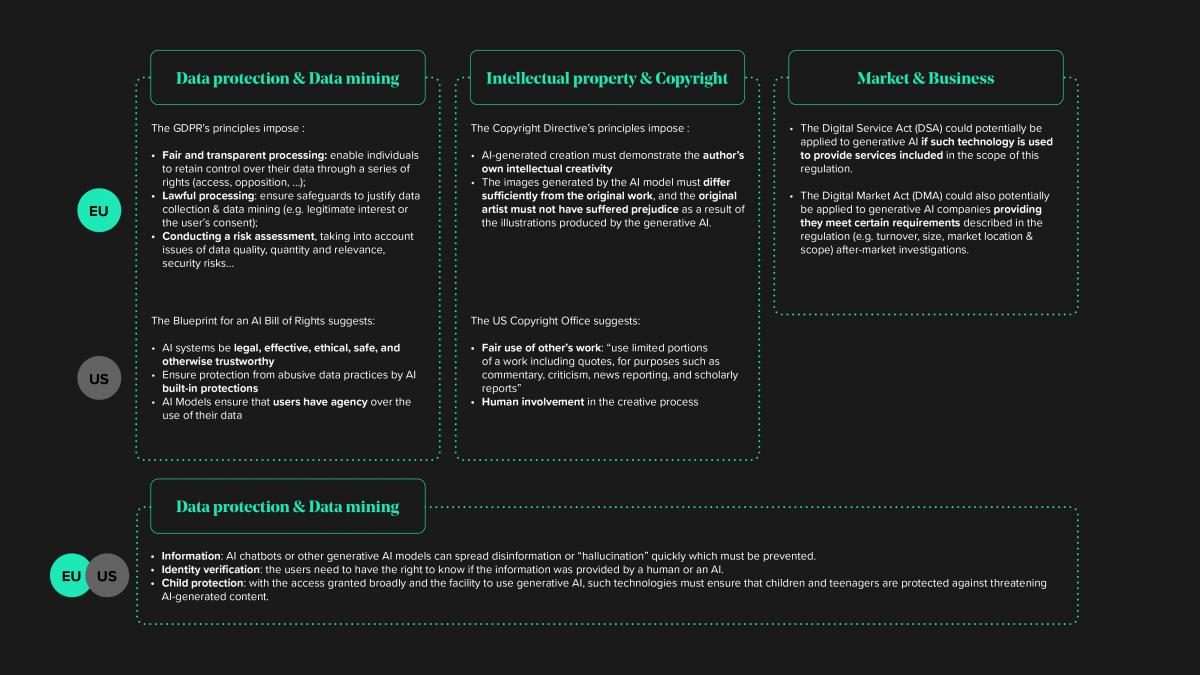
Regulatory framework